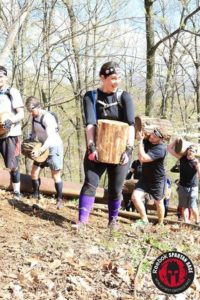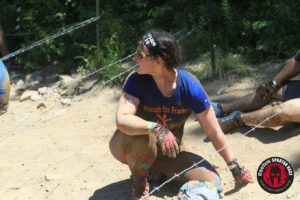While I won’t say that I’m an “expert” Spartan racer, I will say that I’ve put a few notches on my belt at this point. I’ve done at least one of each of the three primary races (Beast, Super, Sprint) in multiple different environments through different kinds of weather. Along the way, I’ve learned a few things.
One of the most anxiety-producing parts of learning to race, for me, has been the research phase of it. While there are a few great reddit threads about Spartan racing, there are very few long-form pieces of knowledge about the races. I spent a great deal of time fervently Googling as I researching, desperately trying to find someone who blogged about what to wear; what to pack, and what to expect. Since I’m now in a position to add to the communal collection of knowledge on these topics, I figured I would do so in hopes of easing someone else’s mind as they themselves prepare for their first Spartan. Discussing Spartans will not take up the entirety of this blog since I know Spartan racing isn’t the only thing my readers might be interested in, but at least for a little while expect to see one entry a week geared towards the Spartans among us.
Today, I want to tackle a great primary question: what should I wear to my Spartan race?
The short answer is: things you wouldn’t mind throwing out after the race, absolutely nothing that’s cotton, and something that will give you protection from the course.
While I haven’t ruined every article of clothing I’ve ever worn on the Mountain (indeed, going through my Spartan photos you might notice that I tend to wear the same shirt to every single OCR; there’s a reason for that and it’s a story I might get into at a later date), I have junked my fair share of clothes. Barbed wire (a mainstay of Spartan racing) is brutal on clothing, and I’ve seen many a racer (myself included) do a great deal of damage to their duds whilst crawling under it. My favorite pair of Spartan pants was ruined this way (may they rest in peace). Mud, rocks, abrasions, and even the obstacles themselves will all take a toll on your kit. On my Beast, I tore the front seam of my pants several inches

Taken just before the finish line on my Beast. You can… not really see the wardrobe malfunction I mention (but trust me, it’s there)
coming over the incline wall (luckily it was late in the race and my shirt covered most of the tear so this wasn’t as embarrassing as it could have been). I’ve worn holes in multiple pairs of socks (they get wet making the fibers of the fabric more delicate, and then the constant pounding of running just shreds them). I haven’t lost a shirt yet to the race, but I’ve seen plenty of people do so. My point: don’t expect to get anything back from the cruel mistress that is the Mountain.
Quick-dry fabrics are a MUST. You will get wet and muddy (unless you’re doing a stadium sprint, in which case you will probably just get sweaty). Quick dry fabrics will work to keep moisture off your body, and if it’s not a terribly humid day will even dry out most of the way as you run. This will mean that your body can more efficiently keep cool (since sweat won’t be stuck to your skin but will, rather, evaporate as nature intended); or even warm on a cold day (who really wants to be stuck in a sticky cotton tee shirt when it’s in the mid-sixties?). When I say wear quick-dry fabrics head to toe, I mean it. Quick-dry socks can be purchased at a running store; so can quick-dry underwear. Trust me; the last thing you want is for it to be swampy in the nether region while you’re trying to carry a bucket that weighs half what you do up a hill in the pounding heat. Also: dampness promotes bacterial development. Particularly for us ladies, it’s important to pay heed to keeping it as dry as possible where the sun don’t shine. I was on the Mountain for 8 hours to complete my Beast; I sure as heck didn’t want to be growing a veritable petri dish in my pants that whole time.
During a Spartan, you will be crawling on rocky, muddy ground. You will be climbing ropes. You will be using your knee pits to hang on to netting and lines. You want to wear something that will protect your knees, legs, and (if possible) elbows and arms from the various hazards of the course. It took me a few years to figure out that if I wore soft leggings, I could roll them up to capri length for most of a hot course, then roll down the

I wore layers on my Beast (the long sleeved top layer eventually got removed as it warmed up) but you can see that I wore long socks with my capris
legs when I wanted full leg protection. This also means that the extra fabric acts as a bit of a cushion for my knees when I want it to. Rope climbs are not something to be done without a layer of fabric between your shins and the rope; trust me. If you must wear shorts, consider wearing long socks that cover your knees to give your poor skin something between it and the abrasive surfaces you will inevitably encounter.
I wear gloves on Spartan courses because I like to have something between my hands and the ground for doing burpees and barbed wire crawls. They also help save my hands on things like the Herc hoist and cargo climbs. I take my gloves off when I do the rope climb, monkey bars, or anything when I want to be sure of my grip. My gloves are great, but they do tend to get slippery when wet or covered in mud (which happens quickly on the course). I use batting gloves; they are unlined leather gloves, cheaply available online or in a sporting goods store. They are also quick-dry, and I’ve run mine through the washing machine several times now with no issues (they do shrink a little when you do this, but I’ll take that over the hassle of hand-washing).

My pink gloves are pretty distinctive; and as you can see from this shot kept my hands from getting totally dusty in this dust bowl
Last, but certainly not least, shoes. When I first started doing Spartan runs, I wore old running shoes that I was going to get rid of anyway. This was fine for a while until I realized that 1) I was going through “disposable” shoes faster than I could make “disposable” shoes and 2) for a relatively nominal investment, I could get a pair of shoes built to handle Spartan trails that would wash off between races. Undoubtedly, the coin of the realm for Spartan shoes is the Inov-8 X-Talon (or the Inov-8 Mud-claw). Unfortunately, these shoes run extremely narrow and I have pretty large, wide feet. After doing much research and reading many reviews, I settled on the Salomon Speedcross 3. I have never looked back. These shoes are awesome because they have a cleat which sticks into the mud and lets you glide across it like a elf on snow. I didn’t realize how much I was struggling needlessly with the loose trails of a Spartan course until I picked up these shoes. If you’re even semi-seriously considering doing more than one Spartan, I would highly recommend a pair of trail shoes. Make sure they’ve got great drainage (again, you will get wet); and make sure they fit you well. Remember that for trail running you want a closer-fitting shoe than you do for road-running; no slipping and sliding in those puppies!
I’ve already been over my sunglasses thing so you know how I feel about eye protection (and how to choose a pair of sunglasses that will might survive the course.
And that’s pretty much it. My golden rules for how to dress for a day on the Mountain. I hope these are useful to you; and remember to keep an eye out for future Spartan-themed tips and tricks. I have a whole lot of them!

